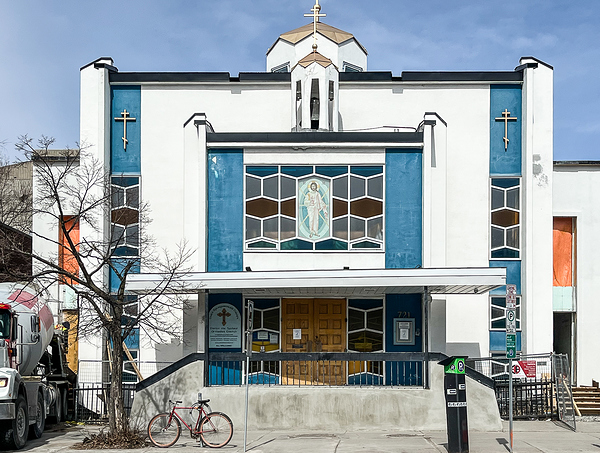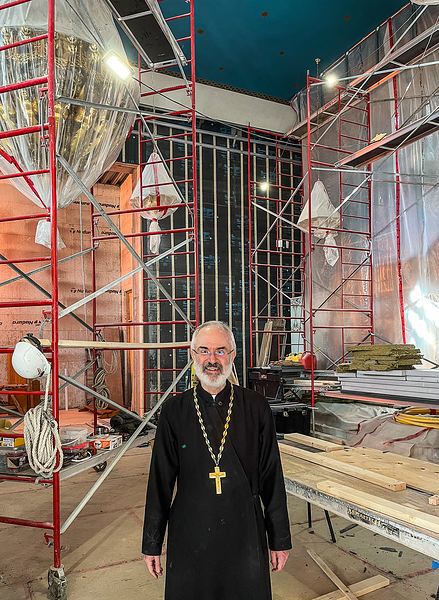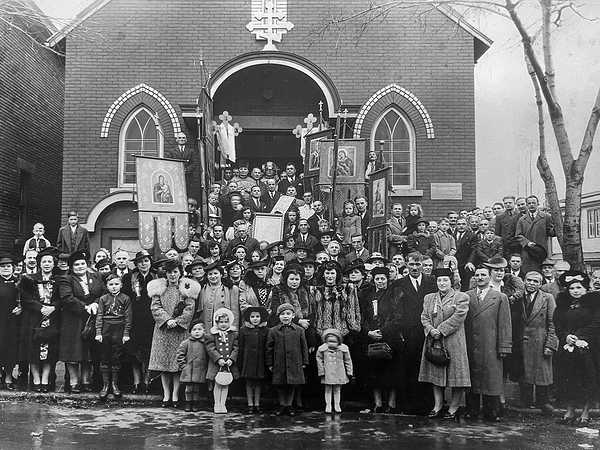
Roger Butt
The white-stuccoed, white-domed Christ the Saviour Orthodox Church is nestled incongruously at 721 Somerset Street West in the heart of Ottawa’s Chinatown.
Anyone passing by over the past year will have noticed the scaffolding and hard hats as the church undergoes a major renovation set to conclude in the next few weeks. This at a time when many religious institutions in Centretown are downsizing or closing their doors.
Father Maxym Lysack, the church’s priest, showed me around the construction site on the day when workers were pouring concrete for a baptismal font and others were readying to break through the brick wall of the adjacent church hall to link the two buildings.
Father Lysack explained that the current church, built in 1968, had reached full capacity about five years ago. Moreover, it had only one fire exit and was woefully inadequate in meeting the needs of those with mobility barriers.
The congregation considered options. They debated selling and building from scratch which would necessitate moving to the outer reaches of the city where land could be secured. Ultimately, they opted to remain and expand.
“We wanted to stay within the city,” he explains. “We liked the idea of people being able to come to church by public transit, which is not the case if you move to the periphery. So, we made this decision, and it was a fateful decision because it is very expensive to retrofit what is essentially a heritage building.”

An architectural jewel
The 1968 structure, celebrated as a now-rare example in Ottawa of 1960s modern architecture, and a favourite among Carleton University architecture students, was something of a happy accident. Acclaimed Ukrainian church architect George Kodak provided the original conceptual design. He was not licensed as an architect in Ontario, however, and so another Ukrainian, Basil Miska, famous for avant-garde architectural experiments, completed the work.
“(Miska) streamlined that design to make it cheaper to build and left his 1960s stamp on it,” explains Lysack. Emblematic of that style are the pre-cast concrete panels that extend out on both sides of the church. The Adult High School on Rochester has a similar style.
Underneath the modernist exterior, however, can be found the three traditional elements of Orthodox church design: the dome, the cube interior with its impressive height, and excellent acoustics, minimizing the need for amplification.
Renovating such a creation was an architectural and engineering challenge assumed by Gatineau architect Paul Cooper and engineering firm, Capacity Engineering. “Our architect analyzed the original building and the addition is a very successful attempt to respect the original architecture and not do something that would diminish it.”
The engineering challenge was to add space without the need of exterior supports and to bring it up to current seismic standards.
“They used structural engineering models that would keep the exterior of the church the same… It’s so well done architecturally that it looks like that’s the way the church was built,” Lysack notes.
The expansion on the east and west sides will add 500 square feet to the church. A new interior link to the church hall on 50 Arthur will convert the formerly separate buildings into one continuous space. Two accessible entrances and washrooms will dramatically improve accessibility of the space for people with disabilities. Finally, multiple new fire exits mean that the capacity of the building will increase to 290 from its current 160.

Deep roots in Centretown
This extensive renovation and expansion of the church is only the latest renewal in the long history of what is the oldest Orthodox congregation in Ottawa. It traces its origins to the Holy Trinity Bukowinian Orthodox Cathedral, founded at the beginning of World War I by Ukrainian immigrants from the Bukovyna region of the Austro-Hungarian Empire (now divided between Ukraine and Romania).
The Cathedral, completed in 1918, was located on the south side of Gladstone Avenue, between Booth and Rochester, land now being redeveloped as new affordable housing. Together with its neighbour, the Ukrainian Catholic Church, located where the Adult High School now sits, it ministered to the spiritual needs of the sizeable Ukrainian population that lived in this part of Centretown.
Of course, Rochesterville, as the area was known, was home to many immigrants at the time from Poland, Italy and elsewhere, settling in alongside Anglo-Celtic and French Canadian neighbours,
In 1965, the City of Ottawa expropriated both Ukrainian churches in the Gladstone area as Queensway construction began and “urban renewal” started in earnest. In the negotiation that ensued, the congregation received two properties: the decommissioned No. 7 Fire Hall at 58 Arthur and a vacant lot at 721 Somerset. The congregation set up a temporary space in the fire hall and began the work to build a new church on the Somerset lot. It opened its doors in 1968, 50 years after the consecration of its predecessor.
By 2003, the congregation was dwindling in numbers and exploring options for its future. It entered into discussions with a new Orthodox congregation worshipping in English that had begun in the early-1980s, using the chapel at All Saints Anglican Church in Westboro. Leading that congregation was Father Maxym Lysack. The two congregations merged, and started worshipping together on July 21, 2003.
“It was a very good fit,” Lysack reflects. “It was basically a Ukrainian English parish joining a Ukrainian parish wanting to become more English.”
Several years into the union, Father Lysack would learn that his own maternal grandparents had been among the original Bukowinian immigrants who had raised money to buy land on Gladstone to build the church and that his grandfather served on the first Parish Council.
The renovation has proceeded at a time when those who trace their origins to Ukraine are reeling as a result of the invasion by Russia and the protracted war.
Supporting a new wave of Ukrainian newcomers
While the church is now very multicultural and multilingual, with no dominant group, its Ukrainian history has attracted new families amongst those who have come to Ottawa seeking refuge.
As a result, a church founded by Ukrainian immigrants fleeing Europe over 100 years ago now finds itself on the front lines helping a new wave of Ukrainian newcomers, together with the two other Ukrainian churches in the city.
“This is emotional for me,” Lysack observes. “A lot of them have been deeply traumatized. A number of them can’t go back to their cities – not now and who knows if ever… We do everything we can to help them settle in. We have people in our parish who help them with everything: opening bank accounts, getting OHIP, finding work, finding housing and furniture, getting into English courses.
“And we provide a home for them pastorally to meet their spiritual needs… It has meant that I am now typically reading the Gospel in English, French, and Ukrainian and using some Ukrainian in sermons and using more Ukrainian in my pastoral work than I have ever done before.”
It was not a mission the church sought. It is clearly one that it embraces. In its newly and beautifully refurbished space, it will be better equipped to face this and other challenges as it looks resolutely to the future.
